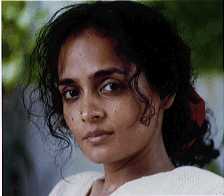| the-south-asian.com SEPTEMBER 2001 | ||
| about us contact us data bank past issues the craft shop the print gallery | ||
|
SEPTEMBER 2001 Contents Interview Heritage Cultural Heritage of south Asia People Communities Lifestyle Films Editor's Note
Books
|
Page 4 of 6 Arundhati Roy interviewed by David Barsamian (continued)
"People have to understand that (dams are) just monuments to political corruption, and they derive from very undemocratic political institutions. ...for contractors and politicians, just building the dam in itself is a lot of money." Q: You say that the government of India is "hell-bent on completing the project." What's driving it?Roy: There are many things. First of all, you have to understand that the myth of big dams is something that's sold to us from the time we're three years old in every school textbook. Nehru said, "Dams are the temples of modern India." So they're like some kind of huge, wet national flags. Before the NBA, it was like, the dam will serve you breakfast in bed, it will get your daughter married and cure your jaundice. People have to understand that they're just monuments to political corruption, and they derive from very undemocratic political institutions. You just centralize natural resources, snatch them away from people, and then you decide who you're going to give them to.The first dam that was built in the Narmada was the Bargi, completed in 1990. They said it would displace 70,000 people and submerge 101 villages. One day, without warning, the government filled the reservoir, and 114,000 people were displaced and 162 villages were submerged. People were driven from their homes when the waters rose. All they could do was run up the hill with their cattle and children. Ten years later, that dam irrigates 5 percent of the land that they said it would. It irrigates less land than it submerged. They haven't built canals. Because for contractors and politicians, just building the dam in itself is a lot of money.Q: What happens to those who are displaced? Roy: Nobody knows. When I was writing "The Greater Common Good," what shocked me more than the figures that do exist are the figures that don't exist. The Indian government does not have any estimate of how many people have been displaced by big dams. I think that's not just a failure of the state, but a failure of the intellectual community. The reason that there aren't these figures is because most of the people that are displaced are again the non-people, the Adivasis and the Dalits. I did a sanity check based on a study of fifty-four dams done by the Indian Institute of Public Administration. According to that study, just reservoir-displaced, which is only one kind of displacement, came to an average of something like 44,000 people per dam. Let's assume that these fifty-four dams are the bigger of the big dams. Let's quarter this average. We know that India has had 3,600 big dams built in the last fifty years. So just a sanity check says that it's thirty-three million people displaced. They all just migrate to the cities. And there, again, they are non-citizens, living in slums. They are subject to being kicked out at any minute, anytime the housewives of New Delhi's upscale areas decide that all these slum people are dangerous.Q: You've compared this uprooting to a kind of garbage disposal.Roy: It's exactly like that. Nonviolent resistance and nonviolent governance. Unlike, say, China or Turkey or Indonesia, India doesn't mow down its people. It doesn't kill people who are refusing to move. It just waits it out. It continues to do what it has to do and ignores the consequences. Because of the caste system, because of the fact that there is no social link between those who make the decisions and those who suffer the decisions, it just goes ahead and does what it wants. The people also assume that this is their lot, their karma, what was written. It's quite an efficient way of doing things.
Copyright © 2000 - 2001 [the-south-asian.com]. Intellectual Property. All rights reserved. |
|
